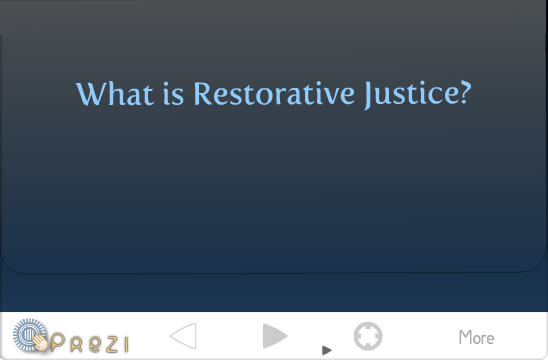A group was run at HMP Bristol in 2004, following the Victim Impact Groups described above. A victim of burglary approached the project through Victim Support. She wanted to meet her offender. Unfortunately, he was no longer in Bristol Prison. However, the restorative justice coordinator met with her and her supporter from Victim Support to explain this and to explore what she had hoped to get out of such a meeting. She had a lot of general questions about offending behaviour, specifically related to drug use, so the coordinator asked if she felt it would be helpful to meet men who had committed similar crimes. She felt it would. The coordinator approached four men, all of whom had attended a Victim Impact Group. They were all very keen to take part, feeling that it was “an opportunity to help a victim”. One man was moved to another prison a few days later, leaving three to meet with the victim.
The victim came to look round the prison the week before the meeting, and had a number of preparatory discussions with the coordinator. She was told she would meet with three men, although two of them might be transferred at any time. The number was chosen to avoid the intensity of a one-to-one meeting, and to give her a number of different perspectives. More than three would have been too many.
Finding a suitable room in the prison was also tricky. The room needed adequate security for the three prisoners, yet some privacy too. A room in the Education Block seemed the most suitable. The restorative justice coordinator liaised with the education administrator, the prison wing officers, the security staff and a psychology assistant, to ensure that the men were unlocked, tea and coffee were available, and the room was empty, so that the victim could settle in first. Meanwhile the restorative justice coordinator was at the prison gate to meet the victim and her supporter from Victim Support, and escort them to the room.
The meeting went really well, despite all the participants being extremely nervous. The victim felt able to talk and take charge, and the men respected her right to do that. They talked very openly about their drug problems and crimes when she asked them to, and explained how they felt. She asked lots of questions and they responded as best they could. She asked about whether they blamed their victims for being in prison and they all said no. Indeed it seemed that this had never occurred to them. She was scared her attacker would come after her when he was out, and they gave their perspectives on how unlikely that was, given what she had told them.
This seemed to reassure her. The meeting lasted about two hours with a short coffee break. The atmosphere lightened and everyone seemed to relax more as it went on. The men showed a great deal of kindness to the victim and, when she got very upset partway through, seemed to want to do anything they could to help her.
The victim rated the meeting in terms of satisfaction as ten out of ten. She felt she had achieved a greater understanding, and had been listened to. She was very glad she had come into the prison to meet with them. The restorative justice coordinator met the victim once after the meeting and spoke with her on the phone three times – to check out her feelings and whether there was anything else she needed. She asked if she could write to the men. The coordinator sought their permission and it was given. The victim sent them all separate notes thanking them for meeting her and wishing them well in the future.
The coordinator saw all the men individually and gave them the chance to talk through how the meeting had affected them. They all seemed delighted to receive a note from the victim and felt they would keep it to help them in the future. A couple still seemed greatly affected by how distressed she had been and showed enormous concern for her. The men felt honoured that they had been given the opportunity to meet her and help her in some way. They felt this was something tangible they could do to atone for their crimes. They also felt that it had really brought home to them the long-lasting effect of crime on some victims.
Source: Marian Liebmann’s book, ‘Restorative Justice: How it works’ (2007, Jessica Kingsley Publishers)








No comments